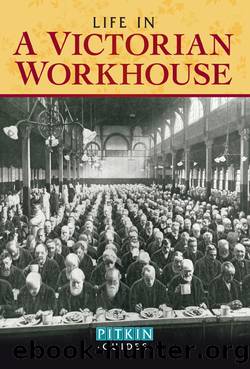Life in a Victorian Workhouse by Peter Higginbotham

Author:Peter Higginbotham [Higginbotham, Peter]
Language: eng
Format: epub
Tags: History
ISBN: 9781841653389
Goodreads: 12953323
Publisher: Pitkin Unichrome Ltd
Published: 2011-03-23T00:00:00+00:00
CHARLIE CHAPLINâS SCHOOLDAYS
In the 1890s, seven-year-old Charlie Chaplin spent some time in a âbarrack schoolâ, the Central London District School at Hanwell. He later recalled the schoolâs strict discipline â on Friday mornings, all the boys were lined up to witness the severe canings given to anyone who had stepped out of line.
WORKHOUSE MEDICAL CARE
Medical care in the mid-Victorian workhouse was often very basic. Every workhouse provided some kind of infirmary for the treatment of sick inmates, but it was often cramped and badly ventilated. Each workhouse was also required to employ a qualified medical officer, although he was frequently poorly paid, and any medicines he prescribed might need to be paid for out of his own salary.
Early nursing care in the union workhouse was usually in the hands of female inmates who would often not be able to read, a serious problem when dealing with labels on medicine bottles. Before 1863, not a single trained nurse was employed in any workhouse infirmary outside London.
In the 1860s, pressure began for improvements in workhouse medical care. Campaigners included nursing pioneer Florence Nightingale, the author Charles Dickens, and Dr Joseph Rogers who had been horrified at the conditions he had found at the Strand Union workhouse in London after becoming its medical officer. Another important contribution came from the medical journal The Lancet. In 1865 it began publishing a series of detailed reports about the appalling conditions in London's workhouse infirmaries.
In 1867 the Metropolitan Poor Act was passed, requiring London workhouses to locate their hospital facilities on separate sites from the workhouse.
The Act also led to the creation of the Metropolitan Asylums Board, which took over the provision of much of the medical care for the sick poor in London and set up its own institutions for the treatment of smallpox, fever, tuberculosis and venereal diseases. Florence Nightingaleâs campaigning also led to improvements in the standard of nursing care with the founding in 1860 of the Nightingale Fund School at Londonâs St Thomasâs Hospital.
Workhouse inmates often included a number of those suffering from mental illness or learning difficulties. Although county asylums existed for dealing with such people, many â particularly those who were not disruptive â remained in the workhouse as this was a cheaper option for the union.
Originally, workhouse infirmaries were intended solely for the care of workhouse inmates. From the 1880s, however, admission to workhouse infirmaries was increasingly permitted to those who, though poor, were not sufficiently destitute to require entry to the workhouse. Like all recipients of union relief, such patients first needed to have their means assessed by the unionâs Relieving Officer and in some cases might be required to contribute towards their maintenance while resident in the infirmary. Prior to 1918, receipt of poor relief disqualified the recipient from voting. The 1885 Medical Relief Disqualification Removal Act recognized the widening of access to workhouse infirmaries and instructed that anyone who was in receipt only of poor-rate-funded medical care no longer lost the right to vote.
The admission of
Download
This site does not store any files on its server. We only index and link to content provided by other sites. Please contact the content providers to delete copyright contents if any and email us, we'll remove relevant links or contents immediately.
Cecilia; Or, Memoirs of an Heiress — Volume 1 by Fanny Burney(32011)
Cecilia; Or, Memoirs of an Heiress — Volume 3 by Fanny Burney(31433)
Cecilia; Or, Memoirs of an Heiress — Volume 2 by Fanny Burney(31374)
The Great Music City by Andrea Baker(30624)
We're Going to Need More Wine by Gabrielle Union(18593)
All the Missing Girls by Megan Miranda(14534)
Pimp by Iceberg Slim(13701)
Bombshells: Glamour Girls of a Lifetime by Sullivan Steve(13658)
Fifty Shades Freed by E L James(12876)
Talking to Strangers by Malcolm Gladwell(12801)
Norse Mythology by Gaiman Neil(12758)
For the Love of Europe by Rick Steves(11318)
Crazy Rich Asians by Kevin Kwan(8850)
Mindhunter: Inside the FBI's Elite Serial Crime Unit by John E. Douglas & Mark Olshaker(8656)
The Lost Art of Listening by Michael P. Nichols(7111)
Enlightenment Now: The Case for Reason, Science, Humanism, and Progress by Steven Pinker(6849)
The Four Agreements by Don Miguel Ruiz(6274)
Bad Blood by John Carreyrou(6247)
Weapons of Math Destruction by Cathy O'Neil(5784)
